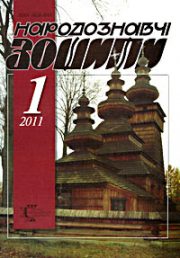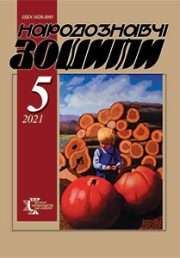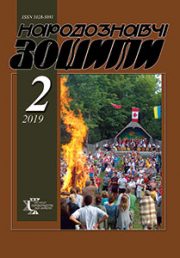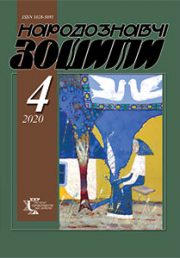The Ethnology Notebooks. 2022. № 3 (165), 608—614
UDK [[39:688.724]:745.51](477.83-21Яворів):[[069.02:[39+745]](477.83-25)(091)
DOI https://doi.org/10.15407/nz2022.03.608
HERUS Lyudmyla
- ORCID ID: https://orcid.org/0000-0002-5931-3816
- Doctor of Sciences in History, Сandidate of Аrts (Ph. D), Head of Department,
- The Institute of Ethnology of the National Academy
- of Sciences of Ukraine,
- Department of Folk Art,
- 15, Svobody Avenue, 79000, Lviv, Ukraine,
- Contacts: e-mail: ludmilagerus@gmail.com
Abstract. Introduction. The collection of toys has come a long way from private collections and thematic exhibitions to creating special «toy museums» in different countries. At the same time, there was an awareness of the toy as a way to solve special tasks — cultural and informational, educational, and so on.
The article purpose is to study the formation process of the Yavoriv toy collection from the Museum of Ethnography and Applied Art of the Ethnology Institute of NAS of Ukraine (Lviv), presenting ways for items, to show their importance in today’s socio-cultural practices.
The study object is the historical and cultural aspects of creating the Yavoriv toy collection from the MEAA EI NAS of Ukraine and the subject — artworks, the practice of their visualization.
The source base consisted of the Yavoriv toy collection of theMEAA EI NAS of Ukraine and inventory books of the Shevchenko Scientific Society Museum.
The study is relevant due to the problem of exhibiting the toy in the museum environment, which arose at an early stage of its collecting. Now the issue is especially acute because of the insufficient adequacy and appropriateness of the museum space to implement the interaction of the toy exhibit and the mass visitors.
The using of the historical method made it possible to trace the formation of the Yavoriv toy collection, identify the influence of socioeconomic factors on it, and determine the contribution of its formation to some individuals. The attribute of items from theMEAA EI NAS of Ukraine with the method of art analysis has been committed, as well as principles and ways of their presentation and the significance for Ukrainian culture have been clarified.
Conclusion. Аt the beginning of the XXI century the collection from the Museum of Ethnography and Applied Art of the Ethnology Institute of NAS of Ukraine quite fully and comprehensively represents Yavoriv toys. The collection items convincingly prove the continuity of the canon formed by many generations of craftsmen and the organic assimilation of tastes and trends in modern times, demonstrating the development of Yavoriv toys for more than a hundred years. The collection reveals the festive, domestic, and religious contexts of human life, in which the toy played an important role. In line with the informational and educational paradigm of the museum’s subject environment, the toy is a historical and cultural artifact that has the potential to deepen museum communication trends and become an object for various museum-pedagogical actions and symposiums related to game culture problems.
Keywords: museum, collection, Yavoriv toy (zabavka), presentation, exhibition.
Received 23.06.2022
REFERENCES
- Herus, L.M. (2004). Ukrainian folk toy. Lviv: IN NANU; Playbill [in Ukrainian].
- Herus, L.M. (1995). Yavoriv folk toy: History of development and modern problems of fishing. Notes of the Shevchenko Scientific Society (Vol. CCXXX (230), рр. 176—189). Lviv [in Ukrainian].
- Barvinsky, O. (1892). On the founding and current development of the society. Shevchenko in Lviv. NTS Notes (Vol. 1, рр. 209—212) [in Ukrainian].
- (1900). Meetings of sections and commissions of the Society. Chronicle of the Ukrainian-Russian Scientific Society named after Shevchenko in Lviv (Part 4, р. 4) Lviv [in Ukrainian].
- (1902). In the case of the Museum of Antiquities at the Scientific Society. Shevchenko. Literary-scientific bulletin (Vol. 17, вook 1, рр. 78—79). Lviv [in Ukrainian].
- Hnatyuk, V. (1909). Word on time. Work, 199, 1 [in Ukrainian].
- (1913). Report from the museum for the months of January — April 1913. For the management of the museum: Ol. Nazariy. Chronicle of the Shevchenko Scientific Society in Lviv (Part 54, pp. 24—31). Lviv [in Ukrainian].
- (1913). Temporary catalog of the Ukrainian National Museum at the Scientific Society. Shevchenko in Lviv. Departments of archeology and ethnography. Lviv [in Ukrainian].
- Chugai, R.V. (1979). Folk decorative and applied art of Yavoriv region. Kyiv: Naukova dumka [in Ukrainian].
- Нerus, L.M. (2018). Yavoriv wooden toy in the works of Oksana Kohut and Ostap Soyka. Our heritage, 2 (14), 50—51 [in Ukrainian].







